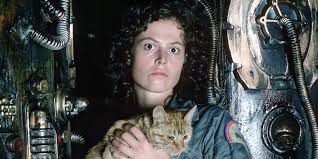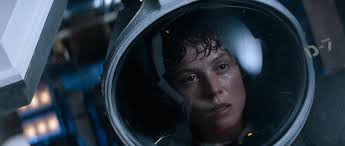Alien (1979)

Alien (1979) Review – A Sci-Fi Horror Masterpiece That Redefined the Genre
Introduction
Ridley Scott’s Alien (1979) is a landmark film in science fiction and horror, blending elements of suspense, isolation, and sheer terror to create an unforgettable cinematic experience. Written by Dan O’Bannon and featuring the iconic design work of H.R. Giger, Alien not only set new standards for creature horror but also introduced audiences to one of the most formidable protagonists in film history—Ellen Ripley (Sigourney Weaver). Over four decades later, the film remains as chilling and impactful as ever. This review explores the film’s plot, themes, performances, cinematography, and cultural significance.
Plot Summary
Set in the distant future, Alien follows the crew of the commercial spaceship Nostromo as they respond to a distress signal from an uncharted planet. Upon landing, they discover a derelict spacecraft housing a nest of mysterious eggs. When one of the eggs hatches, a parasitic creature known as a Facehugger attaches itself to crew member Kane (John Hurt). Unaware of the true horror they have unleashed, the crew brings Kane back aboard, inadvertently allowing the alien lifeform to infiltrate their ship.
As the creature matures into the terrifying Xenomorph, it begins hunting down the crew one by one. Ellen Ripley, the ship’s warrant officer, quickly emerges as the film’s central figure, displaying intelligence and resilience as she fights to survive against the unstoppable predator. The film’s climax, featuring Ripley’s tense escape and battle against the alien, solidifies Alien as a masterclass in suspense and horror.
Themes and Symbolism
Isolation and Fear of the Unknown
One of the film’s most unsettling aspects is its portrayal of isolation. The Nostromo, a massive yet claustrophobic spaceship, becomes a death trap as the crew realizes there is no escape from the alien terror. The vast emptiness of space further reinforces the theme of loneliness and the fear of the unknown.
Parasitic Horror and Body Invasion
The film’s horror is deeply rooted in body invasion and parasitism, particularly through the life cycle of the Xenomorph. The Facehugger’s method of reproduction—implanting an embryo inside a human host—plays on primal fears of violation and loss of bodily autonomy. This disturbing concept has made Alien one of the most psychologically unsettling horror films of all time.
Feminist Strength and Survival
Ellen Ripley, portrayed by Sigourney Weaver, became a groundbreaking character in science fiction cinema. Unlike typical horror heroines of the time, Ripley is resourceful, intelligent, and capable. Her survival is not a matter of luck but rather her ability to adapt, strategize, and face her fears head-on. This role helped redefine female characters in genre films, paving the way for stronger representations of women in action and horror.
Performances
Sigourney Weaver as Ellen Ripley
Weaver delivers a career-defining performance as Ripley, blending vulnerability with unyielding strength. Her transformation from a by-the-books officer to a full-fledged survivor and warrior is one of the most compelling aspects of the film.
John Hurt as Kane
Hurt’s performance is unforgettable, particularly in the infamous chestburster scene, which remains one of the most shocking moments in cinematic history.
Ian Holm as Ash
Holm’s portrayal of Ash, the secretive and unsettling science officer, adds another layer of tension to the film. His character’s true nature and ultimate betrayal add to the themes of corporate control and expendability of human life.
Supporting Cast
The ensemble cast, including Tom Skerritt (Dallas), Veronica Cartwright (Lambert), Harry Dean Stanton (Brett), and Yaphet Kotto (Parker), all contribute to the film’s authenticity. Their naturalistic performances make the crew interactions feel real, heightening the sense of dread as the alien picks them off one by one.
Cinematography and Visual Effects
Derek Vanlint’s cinematography masterfully balances the industrial realism of the Nostromo with the eerie, otherworldly horror of the alien’s environment. Shadows, tight corridors, and dim lighting create an atmosphere of paranoia and suspense.
H.R. Giger’s biomechanical design of the Xenomorph remains one of the most iconic creature designs in film history. The unsettling, almost sexualized imagery of the alien enhances its otherworldly horror, making it one of the most terrifying creatures ever put on screen.
Music and Sound Design
Jerry Goldsmith’s score adds to the film’s eerie, suspenseful tone. The combination of haunting orchestral music and moments of silence creates an unsettling atmosphere, amplifying the tension in key scenes. The sound design, from the mechanical hum of the ship to the alien’s terrifying screeches, immerses the audience in the film’s horror.
Cultural Impact and Legacy
Since its release, Alien has spawned a massive franchise, including sequels, spin-offs, novels, video games, and comic books. The character of Ripley has become one of the most iconic protagonists in film history, and the Xenomorph remains a staple of science fiction horror.
The film’s themes have been extensively analyzed in academic and cinematic circles, influencing countless filmmakers. Its impact on both the sci-fi and horror genres is undeniable, with films like The Thing, Event Horizon, and Life drawing clear inspiration from Alien.
Final Verdict
Alien (1979) is a masterpiece of science fiction horror. With its groundbreaking creature design, suspenseful storytelling, and unforgettable performances, it remains a benchmark for both genres. Whether you are a fan of horror, sci-fi, or cinema in general, Alien is a must-watch that continues to terrify and inspire audiences.
For those who appreciate films like The Thing and Blade Runner, Alien offers an experience that is both thrilling and thought-provoking. Its legacy endures, proving that in space, no one can hear you scream.











